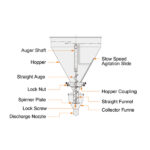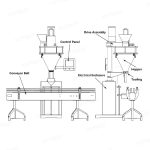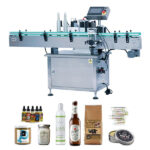Net weight filling machine from VKPAK, as the name suggests, work on the principle of filling each container to a pre-set weight. Using a scale for each container to be filled and a PLC with touchscreen interface to create set points for the fill. Net weight fillers are ideal for highly accurate fills when a product is sold and labeled by weight.
Net Weight Filler Working Principle
The product bulk supply is pumped into a holding tank above a set of pneumatically operated valves. Each valve is independently timed by the filler’s master computer so that precise amounts of liquid will flow by gravity into the container. Gravity fillers built with bottom up fill capability can handle a wide range of flowable liquids including foamy products.

Applications
This type of filler is best suited for liquids filled in bulk quantities e.g. 5 gallon pails, etc. or products that have a very high manufactured value.
Examples
Water, solvents, alcohol, specialty chemicals, paint, inks, corrosive chemicals i.e. acids and bleach.
Advantages
This is sometimes the only practical (and legal) type of filling for a limited range of applications and for large volume fills.
How does a net weight filler work?
Essentially, the way net-weight filling works is like having an advanced electronic weighing scale underneath the bottle to tell you how much product you have filled into the bottle. Firstly, the load-cell is controlled by an electronic card which would feedback each filling cycle. This feedback is used to auto-correct itself using a well designed algorithm for the next cycle. This is critical because product properties change due to change in temperature and pressure, which could directly affect the ‘in-flight’ product and hence the final weight. Moreover, this ensures that each filling cycle is independent to the next. Therefore, the filler is constantly adjusting itself to attain the highest accuracy for the specified weight to be filled.
When an empty bottle is transferred onto the load-plate of the filler, the first step of the filler is to measure the empty bottle weight, also known as tare weight. The filler will record this tare weight and measure whether it is within the expected tolerance defined in the recipe. If the tare weight is outside of the tolerance, a signal is sent to that particular filling station not to fill the bottle for that cycle, and thereby reject it.
Once the tare weight is recorded and accepted by the filler, the nozzle is then actuated to fill the product into the bottle. The bottle is filled with a laminar flow. Laminar flow ensures that there is a constant flow with little turbulence during filling, which helps to avoid or reduce foaming due to product characteristics. Due to constant monitoring of filling process against a filling graph, this is also the stage where the filler is able to detect if product is leaking out of the bottle (due to leak in bottle or improper positioning of bottle). In such a case the filling graph deviates from standard. When this happens, filling is stopped and bottle reject at end of the cycle.
At the next stage after filling the bottles are measured for the final weight once the nozzle has been closed. This is the final stage of measuring the weight of the bottle with the product settled. The filler simply subtracts the tare weight from the final weight of the bottle to get the net-weight of the liquid. The filler will record the weight and calculate several data such as tolerance of the final weight and standard deviation. While the bottle proceeds to the capping station, the filling carousel continues to complete the cycle and accept the next bottle. In this process, the load cell is zero-set before receiving the next bottle.
Net weight fillers
While many filling technologies exist, gravimetric or net weight fillers remain a predominant fill method in the CASE industry. These fillers utilize a scale to measure the precise amount of product dispensed to a container. They have replaced other fill methods due to their ease of automation, flexibility to handle multiple container sizes and varying product densities, and ability to maintain accuracy even with products containing entrapped air.
Net weight fillers are supplied in both automatic and semi-automatic configurations. Semi-automatic fillers feature one or two fill heads. During semi-automatic operation, the operator places containers under each fill head. A button is pressed to initiate fill, and fill stops when the targeted weight is reached. The operator removes the filled containers, and the process begins again.
Automatic fillers are used to achieve faster container rates and reduced operator intervention. VKPAK available in four, six, and eight head configurations, automatic fillers index containers under the fill heads from an upstream queue. The fill cycle starts and stops automatically, and new containers move under the fill heads as full containers proceed downstream.
Filling Process
Several factors affect container fill rates and accuracy. A slower fill rate produces more accurate container filling. However, a higher flow rate is desirable for faster throughput. Since valve response is not instantaneous and product is in freefall, which is outside the readings of the scale, flow is stopped before the target weight is reached. A preact weight is therefore determined to account for material entering the container after the valves are signaled to close.
Three set points are controlled during the filling process: target weight, dribble weight, and preact. Valve operation occurs without operator intervention for both automatic and semi-automatic container filling. The fill cycle begins at rapid fill and then switches to dribble. When preact is reached, the valve close is initiated. Once all flow stops, the container reaches its target weight.
Nozzle Selection
Nozzles are an important part of liquid filling machines. Product characteristics and container types and sizes dictate the best nozzle choices. The four main nozzle types include shower head, cone nozzle, plug nozzle, and fill lance.
When filling large open-top containers, the vented cone nozzle is an ideal choice because it operates over a large viscosity range. As product flows past the cone, it forms a 360˚ curtain, rather than a solid stream. This curtain reduces the likelihood of foaming and splashing. The central vent allows air to escape from the center of the curtain as the liquid level rises. On closing, the cone nozzle produces a sharp cut of material flow, eliminating the dripping and stringing that may be present with other nozzles.

For low- to medium-viscosity products, the shower head nozzle allows for rapid drip-free filling. The shower head features a plate with a series of precision holes. Material flows in a small stream from these holes, reducing the likelihood of splashing. When flow is stopped, capillary action prevents further dripping. Interchangeable plates allow the nozzle to be tailored to a specific product. The shower head nozzle can be supplied in sizes to accommodate ½-pint through 6-gal open-top containers. It is ideal for filling light coatings, solvents, and stains.
Small container openings or high viscosities lend themselves to a plug nozzle. Material exits the plug nozzle in a solid stream. In many applications, the nozzle extends inside the container to eliminate splashing as the solid stream contacts the liquid surface. This type of nozzle is ideal for high-viscosity products, as it provides the least restrictive path for the product to travel and enables higher fill speeds and less backpressure.
When foaming or static is at issue, the lance/probe nozzle is used. The probe nozzle is designed for bottom-up filling. During the fill, the fill lance is extended to the bottom of the container, reducing product free-fall and eliminating foaming. The nozzle is retracted as the liquid level in the container rises. Since the product is typically discharged under the liquid surface, the nozzle will be coated in the product. A drip cup is normally employed to catch material dripping from the nozzle and can direct the material back to subsequent containers.
Advantages of net weight fillers
One big advantage of the net weight filler is that it can provide statistical data of every filling station of every cycle for information tracking & analysis such as standard deviation, mean and median weight of the bottle, or performance of every nozzle can be derived.
Net-weight fillers are also easy to maintain, even during real-time production. If for some reason, there is a faulty load cell or a recurring issue with a particular filling head, it is actually very easy to shut-off that particular head to prevent it from filling. This can easily be done through the touch-screen panel.
Net-weight fillers are also built to be clean and hygienic in design due to its numerous food applications. There is no contact between the nozzle and the bottle, and the filler is designed to prevent product-stagnation for hygienic reasons. It is easy to run CIP (clean-In place) and SIP (sanitize in place) cycles on the net weight filler to ensure hygienic filling.
Ultimately, netweight filling provides greater savings for the manufacturer, which can be passed onto to the end customer in an increasingly competitive market.









